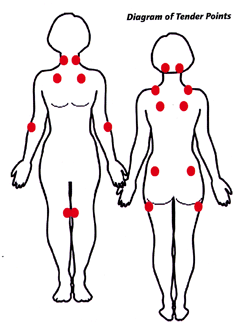Diagnosis

To make a diagnosis of fibromyalgia, healthcare providers rely on patient histories, self-reported symptoms, a physical examination and an accurate manual tender point examination.
It is estimated that it has taken an average of five years for a person with fibromyalgia to receive an accurate diagnosis. Laboratory tests for other illnesses often prove negative; many FM symptoms overlap those of other conditions. This has led to extensive investigative costs and frustration for both the doctor and the patient. Another essential point that must be considered is that the presence of other diseases, such as rheumatoid arthritis or lupus, does not rule out an FM diagnosis. Fibromyalgia is not a diagnosis of exclusion and must be diagnosed by its own characteristic features.
There are two clinical fibromyalgia diagnostic crieteria available to help healthcare providers make an accurate fibromyalgia diagnosis: (1) the 1990 American College of Rhuematology Fibromyalgia Diagnostic Criteria; and (2) and the 2010 American College of Rheumatology Preliminary Diagnostic Criteria.
1990 American College of Rheumatology Fibromyalgia Diagnostic Criteria
In 1990 the American College of Rheumatology (ACR) published diagnostic research criteria for fibromyalgia. It included a history of chronic and widespread body pain and the presence of at least 11 of 18 tender points that are revealed through a physical examination of the patient. Pain is considered widespread when the following are present: pain in both sides of the body; pain above and below the waist. In addition, axial skeletal pain (cervical spine, anterior chest, thoracic spine or low back pain) must be present all lasting for at least three months.
2010 American College of Rheumatology Preliminary Fibromyalgia Diagnostic Criteria
In 2010 a multicenter study was conducted of 829 previously diagnosed fibromyalgia patients and controls utilizing a physician physical and interview examinations, including a widespread pain index (WPI), a measure of the number of painful body regions. Completed analysis data was used to guide the development of a case definition of fibromyalgia, to develop new preliminary ACR diagnostic criteria, and to construct a severity (SS) scale. The most important diagnostic variables were the WPI and categorical scales for cognitive symptoms, un-refreshed sleep, fatigue, and number of somatic symptoms. The categorical scales were summed to create an SS scale which the investigators combined with WPI to recommend a new case definition of fibromyalgia. This criteria does not include a tenderness scale, but rather a 42 question symptom questionnaire. Based on the number of symptoms checked off along with answers to other pertinent diagnostic questions a mathematical formula is used to determine an accurate FM diagnosis.
The good news is that although historically it has taken years and visits to multiple doctors to find out what is wrong with these patients, healthcare professionals are increasingly exposed to educational programs that teach them how to use both of the ACR criterias to make an accurate FM diagnosis. Once a diagnosis is made, it hastens the process for patients in learning about their illness and treatment options.






